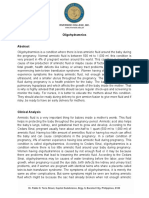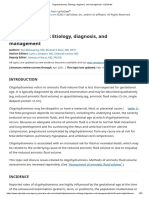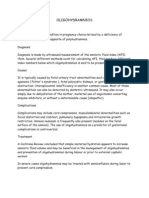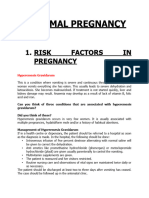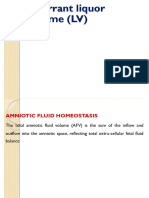Amniotic Fluid
Amniotic Fluid
Uploaded by
blurrycloudCopyright:
Available Formats
Amniotic Fluid
Amniotic Fluid
Uploaded by
blurrycloudCopyright
Available Formats
Share this document
Did you find this document useful?
Is this content inappropriate?
Copyright:
Available Formats
Amniotic Fluid
Amniotic Fluid
Uploaded by
blurrycloudCopyright:
Available Formats
What is amniotic fluid?
Amniotic fluid is an important part of pregnancy and fetal development. This watery fluid is inside a casing called the amniotic
membrane (or sac) and fluid surrounds the fetus throughout pregnancy. Normal amounts may vary, but, generally, women
carry about 500 ml of amniotic fluid. Amniotic fluid helps protect and cushion the fetus and plays an important role in the
development of many of the fetal organs including the lungs, kidneys, and gastrointestinal tract. Fluid is produced by the fetal
lungs and kidneys. It is taken up with fetal swallowing and sent across the placenta to the mother's circulation. Amniotic fluid
problems occur in about 7 percent of pregnancies. Too much or too little amniotic fluid is associated with abnormalities in
development and pregnancy complications. Differences in the amount of fluid may be the cause or the result of the problem.
What causes oligohydramnios?
There are several causes of oligohydramnios. Generally, it is caused by conditions that prevent or reduce amniotic fluid
production. Factors that are associated with oligohydramnios include the following:
premature rupture of membranes (before labor)
intrauterine growth restriction (poor fetal growth)
birth defects, especially kidney and urinary tract malformations
Why is oligohydramnios a concern?
Amniotic fluid is important in the development of fetal organs, especially the lungs. Too little fluid for long periods may cause
abnormal or incomplete development of the lungs called pulmonary hypoplasia. Intrauterine growth restriction (poor fetal
growth) is also associated with decreased amounts of amniotic fluid. Oligohydramnios may be a complication at delivery,
increasing the risk for compression of the umbilical cord and aspiration of thick meconium (baby's first bowel movement).
What are the symptoms of oligohydramnios?
decreased amount of amniotic fluid on ultrasound
The symptoms of the oligohydramnios may resemble other medical conditions. Always consult your physician for a diagnosis.
Treatment for oligohydramnios:
Specific treatment for oligohydramnios will be determined by your physician based on:
your pregnancy, overall health, and medical history
extent of the condition
your tolerance for specific medications, procedures, or therapies
expectations for the course of the condition
your opinion or preference
Treatment for oligohydramnios may include:
closely monitoring the amount of amniotic fluid and frequent follow-up visits with the physician
amnioinfusion - instilling a special fluid into the amniotic sac to replace lost or low levels of amniotic fluid.
Amnioinfusion is still experimental, but it may be offered during pregnancy in an attempt to help prevent pulmonary
hypoplasia (underdeveloped lungs), or at delivery to help prevent compression of the umbilical cord.
delivery (if oligohydramnios endangers the well-being of the fetus, then an early delivery may be necessary)
You might also like
- Surrogacy in The PhilippinesDocument1 pageSurrogacy in The PhilippinesNadine DiamanteNo ratings yet
- AmnioticDocument7 pagesAmnioticCasey del RosarioNo ratings yet
- OligohydramniosDocument3 pagesOligohydramniosReyniel Pablo ElumbaNo ratings yet
- Case StudyDocument5 pagesCase StudyJui Perano100% (2)
- MCN Report Polyhydramnios 1Document24 pagesMCN Report Polyhydramnios 1Vincent CuyucaNo ratings yet
- Low Amniotic Fluid LevelsDocument2 pagesLow Amniotic Fluid LevelspramaNo ratings yet
- მცირე და დიდიწყლიანობაDocument10 pagesმცირე და დიდიწყლიანობაtiko morchadzeNo ratings yet
- Oligohydramnios - Etiology, Diagnosis, and Management - UpToDateDocument23 pagesOligohydramnios - Etiology, Diagnosis, and Management - UpToDateJUAN FRANCISCO OSORIO PENALOZA100% (1)
- Ob Seminar Amniotic Fluid-1Document25 pagesOb Seminar Amniotic Fluid-1Aleena Davis100% (1)
- Polyhydramnios & Oligohydramnios: Prepared By: Hamzah Qarawi To: Miss Mahdia KonyDocument37 pagesPolyhydramnios & Oligohydramnios: Prepared By: Hamzah Qarawi To: Miss Mahdia KonyNinaNo ratings yet
- Polyhydraminos and OligohydraminosDocument11 pagesPolyhydraminos and OligohydraminosMelissa Catherine ChinNo ratings yet
- Amniotic Fluid Index (AFI) - StatPearls - NCBI BookshelfDocument2 pagesAmniotic Fluid Index (AFI) - StatPearls - NCBI BookshelfTarzan SmithNo ratings yet
- 4.hyperemesis & Amniotic Fluid DisorderDocument53 pages4.hyperemesis & Amniotic Fluid DisorderjosephNo ratings yet
- مريم سعد غني GBD OligohydromniospolyhydromniosDocument12 pagesمريم سعد غني GBD OligohydromniospolyhydromniosLubna SaNo ratings yet
- Polyhydramnios 10Document4 pagesPolyhydramnios 10hussain AltaherNo ratings yet
- Polyhydramnios and OligohyramniosDocument35 pagesPolyhydramnios and Oligohyramniosaymanway50% (2)
- ANATOMY and PHYSIOLOGYDocument3 pagesANATOMY and PHYSIOLOGYVien WhitlockNo ratings yet
- LaporDocument4 pagesLapormohammed alkanani100% (1)
- 29 - Amniotic Fluid Volume DisordersDocument13 pages29 - Amniotic Fluid Volume DisordersAbdelrahman ElsaadawiNo ratings yet
- Case Study OligoDocument7 pagesCase Study OligomutiaNo ratings yet
- Lect12 - Amniotic Fluid ModifiedDocument22 pagesLect12 - Amniotic Fluid Modifiedyelisetti DakshayaniNo ratings yet
- Polyhydramnios (Revised)Document34 pagesPolyhydramnios (Revised)Edward Munyaradzi KutsanziraNo ratings yet
- Preparing For A Glucose Tolerance TestDocument3 pagesPreparing For A Glucose Tolerance Testconnect.rohit85No ratings yet
- HydramniosDocument30 pagesHydramniosRahul BaruahNo ratings yet
- Amniotic Fluid and Its Abnormality: DefinitionDocument7 pagesAmniotic Fluid and Its Abnormality: DefinitionpebripulunganNo ratings yet
- OLIGOHYDRAMNIOSDocument3 pagesOLIGOHYDRAMNIOSRuzzel Cabrera-BermonteNo ratings yet
- Polyhydramnios Sem5Document9 pagesPolyhydramnios Sem5Siti Nur AmirahNo ratings yet
- Polyhydramnios & Oligiohydramnios: Prof. Yasmin RaashidDocument11 pagesPolyhydramnios & Oligiohydramnios: Prof. Yasmin RaashidShimmering MoonNo ratings yet
- PolyhydramniosDocument2 pagesPolyhydramniosNathaniel RemandabanNo ratings yet
- Premature Rupture of The MembranesDocument6 pagesPremature Rupture of The MembranesMaria Donabella OngueNo ratings yet
- Hydatidiform MoleDocument15 pagesHydatidiform MoleRegine Mae Morales EncinadaNo ratings yet
- Polyhydra MN IosDocument41 pagesPolyhydra MN IosAbedelrahmanShekhAhmadNo ratings yet
- Management of A Case of Hydramnios and Oligohydramnio1Document12 pagesManagement of A Case of Hydramnios and Oligohydramnio1Easter Soma HageNo ratings yet
- Polyhydramnios and Oligohydramnios Clinical Presentation - Physical ExaminationDocument2 pagesPolyhydramnios and Oligohydramnios Clinical Presentation - Physical ExaminationAhmad FahroziNo ratings yet
- Kelainan Plasenta, Cairan AmnionDocument29 pagesKelainan Plasenta, Cairan AmnionAnggri SeptyanNo ratings yet
- Amniotic Fluid and ItDocument8 pagesAmniotic Fluid and ItSaman SarKoNo ratings yet
- Hydatidiform MoleDocument4 pagesHydatidiform MoleEspiritu, ChriscelNo ratings yet
- Polyhydramnios: SymptomsDocument4 pagesPolyhydramnios: Symptomsbambem aevanNo ratings yet
- Abnormalities of Amniotic FluidDocument27 pagesAbnormalities of Amniotic FluidRukmini kakatikar0% (1)
- Poly and OligohydramniosDocument39 pagesPoly and OligohydramniosMohamed Atef Mohamed100% (1)
- Homework PreemiDocument8 pagesHomework PreemiTeenie Guerrero-GarciaNo ratings yet
- Seminar On PolyhydramniosDocument24 pagesSeminar On Polyhydramnioshonhar youtuberNo ratings yet
- Poly and OligoDocument26 pagesPoly and OligoMAD Bl00DNo ratings yet
- Amniotic Fluid Abnorality PDF'Document31 pagesAmniotic Fluid Abnorality PDF'Aşna Rengîn0% (1)
- AmniocentesisDocument5 pagesAmniocentesiscb_cristian100% (1)
- Government College of Nursing Jodhpur (Raj.) : Procedure On-Amniocentesis Subject-Obstetrics & Gynaecology Specialty-IDocument7 pagesGovernment College of Nursing Jodhpur (Raj.) : Procedure On-Amniocentesis Subject-Obstetrics & Gynaecology Specialty-Ipriyanka100% (2)
- Wilms' Tumor, or Nephroblastoma, - Is The Most CommonDocument9 pagesWilms' Tumor, or Nephroblastoma, - Is The Most CommonKram ZenitramNo ratings yet
- Abnormal PregnancyDocument39 pagesAbnormal Pregnancydenismuema001No ratings yet
- Fetal DistressDocument5 pagesFetal DistressJohn Lorenzo TabijeNo ratings yet
- Gestational Conditions 1Document19 pagesGestational Conditions 1MrLarry Dolor100% (1)
- Amniotic FluidDocument85 pagesAmniotic FluiddrtomorrowmNo ratings yet
- Amniotic Fluid Disoder: Muhammad IzzatDocument26 pagesAmniotic Fluid Disoder: Muhammad IzzatcopperNo ratings yet
- PDF 20230209 133124 0000Document19 pagesPDF 20230209 133124 0000Regine AldamarNo ratings yet
- Amniotic Fluid AnalysisDocument37 pagesAmniotic Fluid AnalysisteachmedilipNo ratings yet
- Amnioticfluid 120212085244 Phpapp01Document43 pagesAmnioticfluid 120212085244 Phpapp01Jhoanie Sanggoy TauliNo ratings yet
- Polyhydramnion: Causes, Diagnosis, TherapyDocument12 pagesPolyhydramnion: Causes, Diagnosis, TherapywadejackNo ratings yet
- AberrantLiquorVolume-2slidesDocument16 pagesAberrantLiquorVolume-2slidesmasterminde1996No ratings yet
- Conceive A Baby Naturally - How To Cure Infertility And Get Pregnant NaturallyFrom EverandConceive A Baby Naturally - How To Cure Infertility And Get Pregnant NaturallyNo ratings yet
- Lyrdia HallDocument5 pagesLyrdia HallblurrycloudNo ratings yet
- VII. Pathophysiology: Modifiable Factors Non Modifiable FactorsDocument2 pagesVII. Pathophysiology: Modifiable Factors Non Modifiable FactorsblurrycloudNo ratings yet
- AddddddddddDocument1 pageAddddddddddblurrycloudNo ratings yet
- Assessment Nursing Diagnosis Planning Nursing Intervention Rationale Evaluation S: STG: Independent STGDocument2 pagesAssessment Nursing Diagnosis Planning Nursing Intervention Rationale Evaluation S: STG: Independent STGblurrycloudNo ratings yet
- Chapter IIIDocument4 pagesChapter IIIblurrycloudNo ratings yet
- SDFFFFFFDocument11 pagesSDFFFFFFblurrycloudNo ratings yet
- VII. Pathophysiology: Modifiable Factors Non Modifiable FactorsDocument2 pagesVII. Pathophysiology: Modifiable Factors Non Modifiable FactorsblurrycloudNo ratings yet
- Word Drugs and NCP Colored (Activity Intolerance Edited)Document10 pagesWord Drugs and NCP Colored (Activity Intolerance Edited)blurrycloudNo ratings yet
- Assessment Nursing Diagnosis Planning Nursing Intervention Rationale Evaluation S: STG: Independent STGDocument2 pagesAssessment Nursing Diagnosis Planning Nursing Intervention Rationale Evaluation S: STG: Independent STGblurrycloudNo ratings yet
- W5Wggv: Booking DetailsDocument4 pagesW5Wggv: Booking DetailsblurrycloudNo ratings yet
- VII. Pathophysiology: Modifiable Factors Non Modifiable FactorsDocument1 pageVII. Pathophysiology: Modifiable Factors Non Modifiable FactorsblurrycloudNo ratings yet
- Activity IntoleranceDocument3 pagesActivity IntoleranceRheegell Ellar-Fuertes50% (2)
- V. Physical Assessment: A. General AppearanceDocument7 pagesV. Physical Assessment: A. General AppearanceblurrycloudNo ratings yet
- Essay Gawin MoDocument20 pagesEssay Gawin MoblurrycloudNo ratings yet
- Grimace, Restless, Weak in Appearance. Cooperative and OrientedDocument1 pageGrimace, Restless, Weak in Appearance. Cooperative and OrientedblurrycloudNo ratings yet
- Height: 5 FT 9 in (1.75 M)Document3 pagesHeight: 5 FT 9 in (1.75 M)blurrycloudNo ratings yet
- Co AmoxiclavDocument2 pagesCo Amoxiclavblurrycloud75% (8)
- Prenatal Care by Connie Sussan AustenDocument31 pagesPrenatal Care by Connie Sussan AustenNoraNo ratings yet
- 4 Artificial Reproductive Technologies - Science 10Document2 pages4 Artificial Reproductive Technologies - Science 10Czy Anne Nicole IlaganNo ratings yet
- Acog Committee Opinion No 766 2018 PDFDocument10 pagesAcog Committee Opinion No 766 2018 PDFDaniel AnatoNo ratings yet
- DystociaDocument12 pagesDystociaKimberly Teofe KwanNo ratings yet
- GROUP 2 - Theories of Labor OnsetDocument17 pagesGROUP 2 - Theories of Labor OnsetCHRISTIAN JAY CALISAGANNo ratings yet
- Shoulder Dystocia: Clinical Practice GuidelineDocument7 pagesShoulder Dystocia: Clinical Practice GuidelineSamantha DavisNo ratings yet
- 2020 National Health Goals Related To Reproductive and Sexual Health.Document2 pages2020 National Health Goals Related To Reproductive and Sexual Health.KHRISTINE KAYE SALUDESNo ratings yet
- Prenatal Screening ProgramDocument48 pagesPrenatal Screening Programrolla_hiraNo ratings yet
- Percakapan Bahasa InggrisDocument5 pagesPercakapan Bahasa Inggrisnovia rohlianaNo ratings yet
- Interstitial Ectopic Pregnancy A Case ReportDocument4 pagesInterstitial Ectopic Pregnancy A Case ReportRina Auliya WahdahNo ratings yet
- ID Penggunaan Kontrasepsi Pada Wanita PascaDocument10 pagesID Penggunaan Kontrasepsi Pada Wanita PascaAndiniNo ratings yet
- Ectopic PregDocument6 pagesEctopic PregYwagar Ywagar0% (1)
- Case Report: Recurrent Cesarean Scar Ectopic Pregnancy Treated With Systemic MethotrexateDocument5 pagesCase Report: Recurrent Cesarean Scar Ectopic Pregnancy Treated With Systemic MethotrexatesaryindrianyNo ratings yet
- MisoprostolDocument2 pagesMisoprostolElvira Anita100% (2)
- INTERGROWTH-21st Abdominal Circumference StandardsDocument1 pageINTERGROWTH-21st Abdominal Circumference StandardsAgustínNo ratings yet
- Abnormal Uterine ActionDocument64 pagesAbnormal Uterine ActionKanimozhi Kasinathan100% (1)
- Fetal Assessment and Wellbeing in Pregnancy (FetalDocument23 pagesFetal Assessment and Wellbeing in Pregnancy (Fetalapi-3705046100% (1)
- How To Play A Pregnant CharactersfsdgDocument4 pagesHow To Play A Pregnant CharactersfsdgGoSangGilNo ratings yet
- 01 M039 43754Document16 pages01 M039 43754DrDeepak PawarNo ratings yet
- Obstetrics QuestionsDocument22 pagesObstetrics QuestionsShaik AmreenNo ratings yet
- BJOG - 2023 - Lee - Tranexamic Acid As An Adjunct To Oxytocin Prophylaxis in The Prevention of Postpartum Haemorrhage inDocument9 pagesBJOG - 2023 - Lee - Tranexamic Acid As An Adjunct To Oxytocin Prophylaxis in The Prevention of Postpartum Haemorrhage inHayfa LayebNo ratings yet
- 2022 March of Dimes Report Card-ArkansasDocument2 pages2022 March of Dimes Report Card-ArkansasCurtisNo ratings yet
- Oligohydramnios Literature Review and Case StudyDocument6 pagesOligohydramnios Literature Review and Case StudyofahxdcndNo ratings yet
- CR3 RobbbDocument86 pagesCR3 RobbbIhsan Rasyid YuldiNo ratings yet
- Updated WHO PPH RecommendationsDocument10 pagesUpdated WHO PPH RecommendationsFitri RahmanianiNo ratings yet
- Chapter 2 MethologyDocument17 pagesChapter 2 MethologyTrisha Mae SamasNo ratings yet
- Pone.0217968 PLUS IDI-KII-FGD GUIDESDocument18 pagesPone.0217968 PLUS IDI-KII-FGD GUIDESAPRADHANNo ratings yet
- Post Partum ComplicationDocument29 pagesPost Partum ComplicationPutri Rizky Amalia100% (1)
- CC Chua, Prince Robert C. Reflection Paper 4ADocument1 pageCC Chua, Prince Robert C. Reflection Paper 4APrince Robert ChuaNo ratings yet


